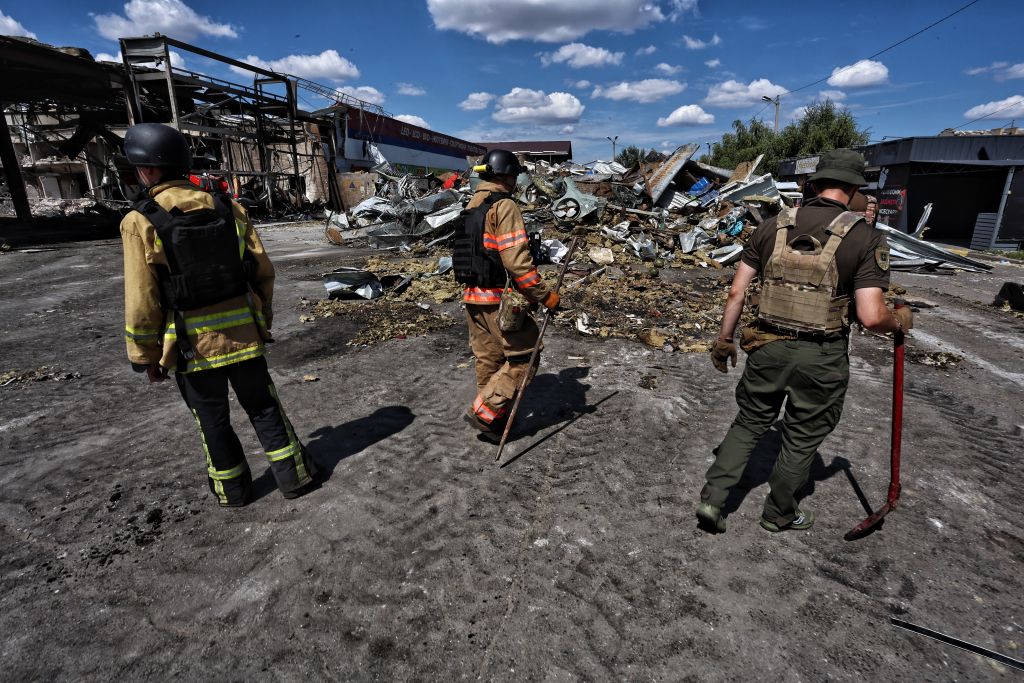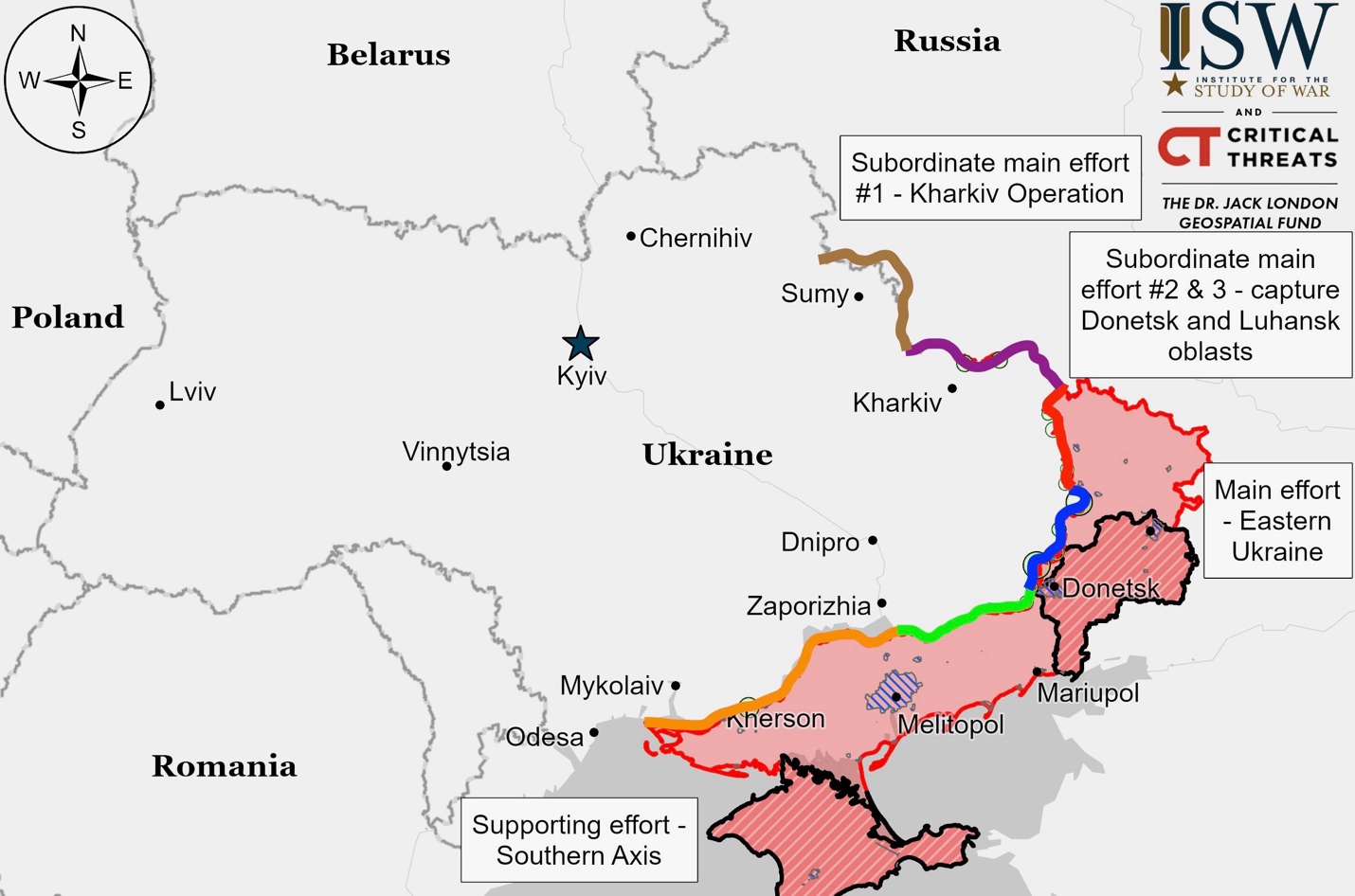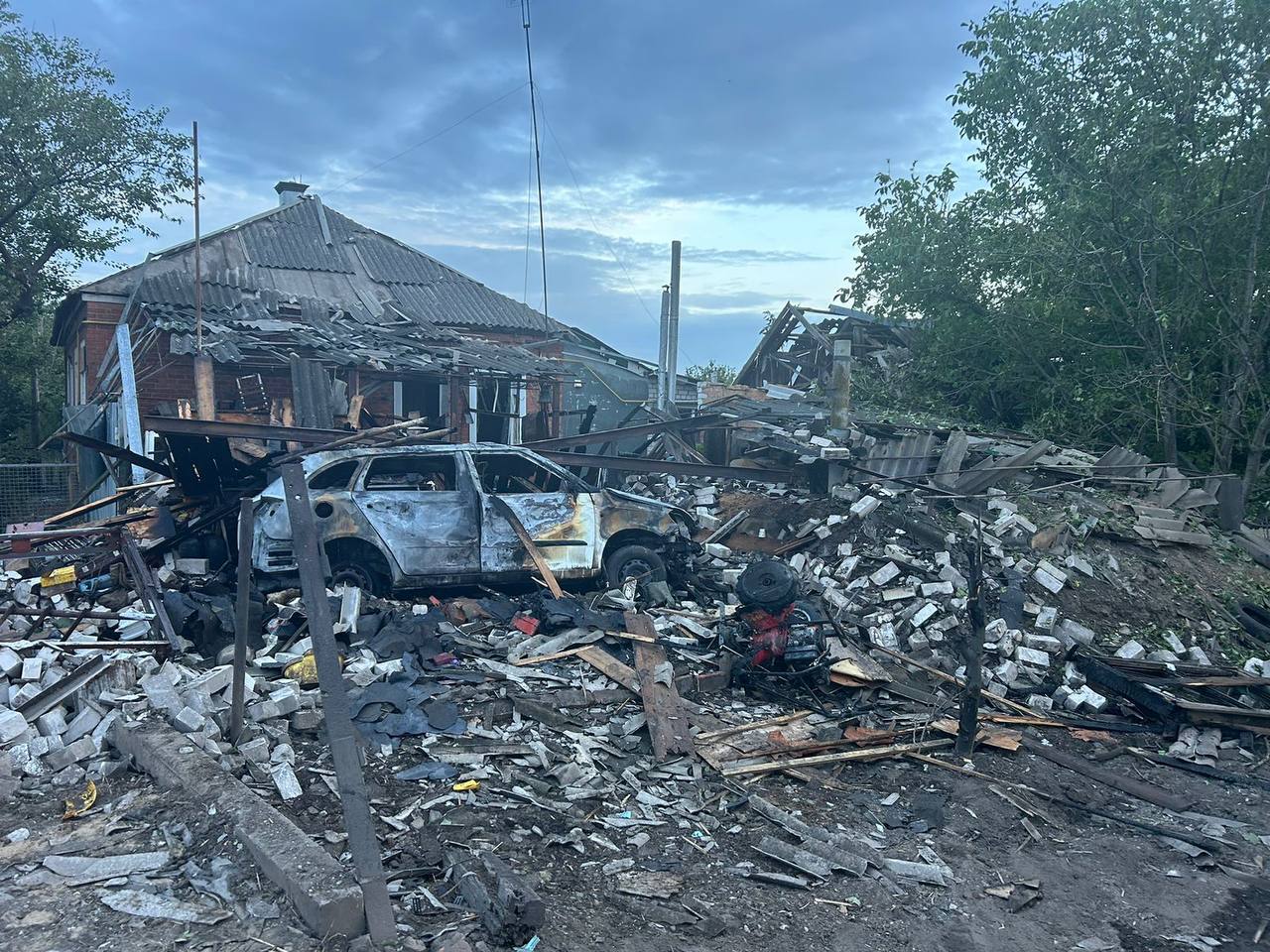Summary of the day: The Russian National Antiterrorism Committee initiated a counterterrorism operation in Belgorod, Bryansk, and Kursk oblasts in response to a Ukrainian incursion. The Kremlin chose this designation to minimize domestic unrest and manage the narrative surrounding the Ukrainian advance. Despite a complex command structure under Bortnikov’s leadership potentially affecting effectiveness, Russia has deployed conscripts and forces from other fronts to bolster defenses in Kursk. Ukrainian forces maintain positions in Kursk Oblast with slight advancements. The ongoing conflict raises potential political issues for the Kremlin, especially concerning conscript casualties. Additionally, developments include a Ukrainian attack on Russian naval assets in the Black Sea and Russia’s formation of a new drone unit funded by public donations.
Picture of the day:
 Rescue workers respond at the site of a Russian missile strike on a supermarket in Kostiantynivka, Donetsk Oblast. On August 9, the Russian army carried out a missile attack on the city of Kostiantynivka, killing at least 14 people, including two children, and injuring 44 more. (Yan Dobronosov/Global Images Ukraine via Getty Images)
Rescue workers respond at the site of a Russian missile strike on a supermarket in Kostiantynivka, Donetsk Oblast. On August 9, the Russian army carried out a missile attack on the city of Kostiantynivka, killing at least 14 people, including two children, and injuring 44 more. (Yan Dobronosov/Global Images Ukraine via Getty Images)
What Can I Do To Help Ukraine? This is a question I receive all the time. We at Transform Ukraine are building longer-term housing for internally displaced Ukrainians. Visit Rebuild Ukraine for how you can assist in housing a Ukrainian family displaced by the war.
Beyond Ukraine – The March Towards World War
The Kremlin is reportedly trying to undermine NATO’s peace efforts in the Balkans. Serbian President Alexander Vucic stated that Russian intelligence warned him of a plot in Serbia, allegedly backed by unspecified “Western powers.”
Situation On The Land, Sea, and Air in Ukraine
The Ukrainian Support Forces Command accused Russian forces of intensifying chemical attacks in Ukraine, specifically using K-51 and RG-VO hand gas grenades containing riot control agents, which are prohibited by the Chemical Weapons Convention. (Russian War Crime)
Ukrainian forces targeted a Russian patrol boat and a gas platform in the western Black Sea. Using a Magura naval drone, Ukraine’s “Group 13” struck and destroyed a Russian KS-701 Tunets patrol boat near Chornomorske, Crimea, during an overnight attack on August 8-9. The strike also damaged three other Russian vessels, which are still being identified. This attack follows previous successful strikes on Tunets boats in May. Additionally, Ukrainian drones hit a Russian gas platform that had been militarized to disrupt civilian shipping in the Black Sea through GPS spoofing. The Magura V5 drone, developed by Ukraine, has been instrumental in these operations, with 18 Russian vessels hit and nine destroyed, including various patrol and landing ships.

Kursk Front – Initiative Ukraine
President Volodymyr Zelensky acknowledged Ukraine’s cross-border incursion into Russia’s Kursk Oblast in his nightly address, stating that Ukrainian forces are “pushing the war out into the aggressor’s territory.” This marks the first public recognition of the operation, which began on August 6. Zelensky praised the Ukrainian military’s efforts to bring the conflict back to Russian soil.
Ukrainian troops reportedly entered Russia’s Belgorod Oblast during their incursion into Kursk Oblast, according to a video posted on August 10. The video shows five soldiers with blue armbands in the village of Poroz, holding their battalion’s flag and a Georgian flag. The sign behind them reads “Porozovsky Village Club.” Ukrainian fact-checkers confirmed the location, but the date and purpose of the video are unclear.
Russia has declared a counterterrorism operation in Belgorod, Bryansk, and Kursk oblasts in response to a Ukrainian incursion into Kursk. The Kremlin has chosen this approach over declaring a state of war or martial law, aiming to prevent extensive domestic disruption and panic. This operation gives authorities the ability to restrict communications and enter private properties, and officials are urged to limit comments to official statements. Despite criticisms from Russian milbloggers advocating for stronger actions like martial law, President Putin seeks to maintain domestic stability without full military mobilization.
Alexander Bortnikov, Director of the Federal Security Service (FSB), has been appointed to lead this operation, due to his previous success in managing internal crises. His role reflects dissatisfaction with the military’s handling of the situation, and the operation includes complex command and control structures involving the FSB, Rosgvardia, and the Ministry of Internal Affairs. This could complicate coordination and diminish effectiveness.
The Russian Ministry of Defense (MoD) has mobilized a mix of forces, including conscripts and units from less critical fronts, to address the incursion. Up to nine brigades, including airborne and naval units, have been relocated to Kursk, though the most crucial units remain in strategic eastern sectors like Pokrovsk and Toretsk. This redeployment has caused some disorganization but is seen as a necessary risk to concentrate on Kursk without weakening positions in high-priority areas. The reconstitution of frequently redeployed units may impact their effectiveness.
The use of conscripts, particularly controversial given Putin’s past assurances to the contrary, has caused political strain as casualties rise and conscripts’ families express discontent on social media. Despite historical precedents for using conscripts in conflicts, recent deployments have sparked public backlash and potential political challenges for the Kremlin.
On the ground, Russian defenses in Kursk have strengthened, slowing Ukrainian advances. Recent engagements have included repelling attacks and recapturing lost positions, with some reported successes against Ukrainian forces. However, Ukrainian troops maintain strong positions in several areas around Kursk, with slight advancements and continued operations despite Russian countermeasures.
Lastly, a reported Russian missile strike aimed at a Ukrainian command post indicates ongoing intense military engagement, though some assessments suggest it missed critical targets. This underscores the ongoing volatility and complexity of the situation in Kursk Oblast.
Kharkiv Front – Initiative Russia
A Russian military blogger refuted claims that Russian forces captured Lukashivka in Sumy Oblast and Sotnytskyi Kozachok in Kharkiv Oblast. He noted that these locations have frequently switched control during the war, citing a lack of strong defensive positions for either side to maintain lasting control.
Russian forces continued offensive operations around northern Kharkiv but did not achieve any changes to the frontline. Clashes were reported north and northeast of Kharkiv City.
Luhansk Front – Initiative Russia
Russian forces advanced near Kreminna and engaged in offensive actions along the Kupyansk-Svatove-Kreminna line. Geolocated footage from August 7 shows Russian movement northwest of Zolotarivka, south of Kreminna, suggesting earlier advances. Claims of advancement west of Novoselivske remain unconfirmed. Ukrainian reports detail Russian offensives southeast of Kupyansk and around Kreminna, including attacks in the Serebryanske forest area.
Donetsk Front – Initiative Russia
Siversk
Russian forces continued offensive operations around Siversk without making advances. Attacks occurred northeast near Bilohorivka, east near Verkhnokamyanske, and southeast near Spirne, Ivano-Darivka, and Vyimka.
Chasiv Yar
Russian forces continued their offensive near Chasiv Yar without confirmed advances. Operations were reported east of Chasiv Yar near Ivanivske and south near Stupochky and Bila Hora. A Kremlin-affiliated milblogger claimed advancement in the Zhovtnevyi Microraion of Chasiv Yar, but this remains unverified. Russian forces are operating southwest of Chasiv Yar in the Oleksandro-Shultyne direction.
Toretsk
Russian forces made slight advances in the Toretsk area, particularly in northern Druzhba and potentially expanded control by 400 meters in Niu York, south of Toretsk. These claims, including advances in fields near Ozaryanivka and Yurivka, remain unconfirmed. Continuous offensive operations were noted near Toretsk, Niu York, and Dyliivka.
Pokrovsk
Russian forces likely captured Nevelske, southeast of Pokrovsk, with geolocated footage showing a Russian flag being raised there on August 9. Claims of Russian advancements near Serhiivka and Lozuvatske and the seizure of Ivanivka remain unconfirmed. Russian military continued offensive operations around Pokrovsk, targeting areas like Vozdvyzhenka, Novooleksandrivka, and southeast near Zhelanne and Karlivka, with significant attacks in Hrodivka and Zhelanne.
Southwest of Donetsk City
Russian forces recently advanced southwest of Donetsk City, particularly near Kostyantynivka, with geolocated footage showing movements in southeastern and northeastern Kostyantynivka, and southeast of Vodyane. They also continued attacks west and southwest of Donetsk City, targeting areas like Krasnohorivka, Heorhiivka, Paraskoviivka, Vodyane, and Oleksandrivka.
Zaporizhia Front – Initiative Russia
Zaporizhia-Donetsk Border Area
Russian air force units continue to operate near Blahodatne, south of Velyka Novosilka, focusing on air defense operations in the area.
Zaporizhia Line
Positional fighting persisted near Mala Tokmachka in western Zaporizhia Oblast.
Kherson (Dnipro River) Front – Initiative Russia
Ukrainian officials reported Russian attacks in the Dnipro area of Kherson Oblast.
Ukraine News
Vadym Filashkin, the head of Donetsk Oblast, reported that Russian forces hit critical infrastructure in Kramatorsk with a missile.
At least 219 civilians were killed and 1,018 injured in Ukraine in July, making it the deadliest month for civilians since October 2022, according to a U.N. report on August 9. The report noted a rising trend in civilian casualties since March 2024, with most casualties and damage occurring in Ukraine-controlled areas. A mass Russian aerial attack on July 8 targeted cities including Kyiv, Dnipro, and Kryvyi Rih, killing over 40 people and injuring 147. Ukraine’s largest children’s hospital, Okhmatdyt, was hit, resulting in two deaths, including a doctor, and significant damage. The U.N. estimates that since the full-scale invasion began in February 2022, at least 11,520 civilians have been killed and 23,640 injured, though the true numbers are likely higher.
Innocent Victims Of War
The casualty count of civilians in the past 24 hours:
DEATHS: 20 INJURIES: 64
- Russian forces attacked Kyiv Oblast overnight killing two people, including a 4-year-old boy, and injuring three others. Missile fragments hit residential buildings in Brovary district. The attack also injured a 13-year-old. (Russian War Crime)
- Russian forces attacked Kherson with drones injuring 10 people, including a 15-year-old boy. Most of the victims, including the teenager, are in moderate condition, while a 74-year-old man is in serious condition. The attack primarily targeted the Dniprovskyi district. (Russian War Crime)
- A Russian missile strike on a supermarket in Kostiantynivka, Donetsk Oblast, on August 9 resulted in at least 14 deaths, including two children aged 9 and 11, and 43 injuries. (Russian War Crime)
- Russian attacks on other settlements in Donetsk Oblast over the past day killed two people and injured another. The attacks damaged over 30 houses, an apartment building, an agricultural facility, and other civilian infrastructure. (Russian War Crime)
- In Kharkiv Oblast, Russian strikes killed an 80-year-old woman and a 24-year-old man, and injured four others aged 32 to 67. The attacks targeted Kharkiv city and nearby districts, damaging 10 houses, a hospital, and an educational facility. (Russian War Crime)
- Russian artillery and drone attacks on the Nikopol district in Dnipropetrovsk Oblast injured three civilians, including a toddler. The attacks damaged several buildings, including four apartments, four houses, a hospital, a sports school, and energy infrastructure. (Russian War Crime)
 The aftermath of a Russian attack on Kharkiv Oblast. (Oleh Syniehubov/Telegram)
The aftermath of a Russian attack on Kharkiv Oblast. (Oleh Syniehubov/Telegram)
Russia News
Russia has evacuated over 76,000 citizens from the Russian-Ukrainian border in Kursk Oblast due to Ukraine’s ongoing incursion. Evacuees are being housed in 60 temporary centers across western Russia, including Moscow Oblast.
Russian Mobilization and Defense Industrial Base
A Russian military blogger reported that the Russian Ministry of Defense is forming a volunteer drone unit called “Black Raven.” They are seeking donations to reach a 16-million-ruble goal to equip the unit with drones and necessary gear.
The Kremlin is taking steps to counteract Western sanctions and support its defense industry. The Russian United Aircraft Corporation announced the production of a new batch of Su-30SM2 fighter jets, which now include Russian-made components instead of foreign ones used in the previous Su-30SM model. Additionally, a Russian military blogger reported that Russian forces are using Iranian-made 130mm OF-482M artillery shells on the front line.
Russia’s Allies
Iran is set to deliver “hundreds” of Fath-360 ballistic missiles to Russia, with delivery expected soon. This was reported by Reuters, citing a contract signed on December 13, 2023, between Russian military officials and Iran. The Fath-360 missiles have a range of 120 kilometers and a 150-kilogram warhead. Additionally, Russian military personnel are training in Iran to operate these systems. These missiles will enable Russian forces to target near-rear positions in Ukraine, conserving their longer-range missiles for more distant targets.
Belarus summoned Ukraine’s Charge d’Affaires, Olha Tymush, on August 10, after claiming Ukrainian drones entered Belarusian airspace near the Kastsyukovichy area on August 9. The Belarusian Foreign Ministry issued a warning, threatening to end diplomatic relations over what it called a “Ukrainian provocation.” President Alexander Lukashenko responded by ordering reinforcements, including special forces and missile units, to the Ukrainian border and vowed to counter any further provocations. Defense Minister Viktor Khrenin also labeled the airspace breach a provocation, ordering additional troops to the Gomel and Mozyr regions. Despite Russian drones frequently crossing into Belarus en route to Ukraine, Minsk has remained largely silent on those incidents. Meanwhile, a Kremlin-linked Russian blogger urged Belarus to increase its support for Russia’s invasion of Ukraine under the Union State agreement.
Controlling The Narrative and Russian Propaganda
The Kremlin is tightening control over Russian information channels. Sources revealed that Vkontakte (VK), a Kremlin-affiliated social media platform, plans to create a “national messenger” to replace WhatsApp in Russia. Additionally, Russian officials announced that Roskomnadzor, the federal censor, will enforce stricter rules, requiring phone numbers for social media accounts and coordinating with telecom companies to block the use of gray market SIM cards for anonymous registrations.
Russian sources claim that Ukrainian forces are using hexachloroethane-equipped grenades in Kursk Oblast, near Sudzha, suggesting a breach of the Chemical Weapons Convention (CWC); however, hexachloroethane is not banned by the CWC as it is commonly used in smoke devices.
Source Material
Institute for the Study of War – understandingwar.org
The Kyiv Independent – kyivindependent.com
Kyiv Post – kyivpost.com
